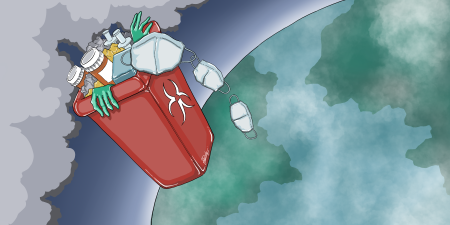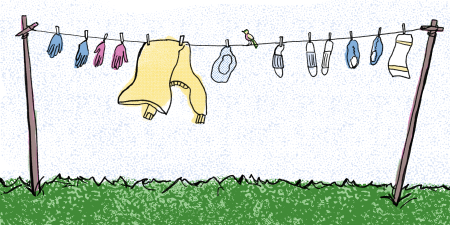Abstract
Pharmaceutical companies’ capital, influence, and labor force well equip them to assume responsibility for public medication disposal programs. Government- and industry-funded campaigns for medication disposal do work, but responsibility often falls on local health care organizations to provide education and services. Lack of public awareness about how to dispose of medications and the ramifications of contaminating our natural resources and ecosystems with pharmaceuticals suggest a need for collaboration among pharmaceutical companies, government officials, clinicians, and patients.
Pharmaceutical Waste
Global pharmaceutical spending has risen from $887 billion in 2010 to $1.27 trillion in 2020.1 The World Health Organization defines pharmaceutical waste as expired, unused, and contaminated drugs and vaccines.2 In the United States, unused prescription medications cost the health care industry approximately $5.4 billion per year for adults who take one prescription medication daily.3 Moreover, disposal of regulated medical waste, including pharmaceuticals, costs 119% more per pound than regular trash.4
As part of a recent shift toward a more environmentally conscious culture in global health care, reducing the environmental impact of pharmaceuticals has become imminently important to preserving soil and water quality and maintaining ecological balance.5 National research studies have revealed the presence of pharmaceuticals in streams throughout the United States, including medicines from the following drug classes: antidepressants (eg, fluoxetine), antibiotics (eg, ciprofloxacin), antihypertensives (eg, lisinopril), and analgesics (eg, acetaminophen, ibuprofen), as well as hormone modulators (eg, estradiol-containing drugs).6,7,8,9 Globally, 631 of 713 pharmaceuticals were found in concentrations above the detection limits, 16 of which were found to be in surface, drinking, and ground water in some countries in Africa, the Asia-Pacific region, Eastern Europe, Latin America and the Caribbean, and Western Europe (including North America, Australia, and New Zealand).10 Diclofenac (a nonsteroidal anti-inflammatory drug) was among the top 5 most detected substances in all the regions tested.10 Previously, Diclofenac was linked to critical endangerment of 3 species of vultures after causing widespread kidney failure.11
Designating responsibility for the source and removal of waste is challenging because there are multiple levels of waste generation throughout the life cycle of a pharmaceutical product—starting with manufacturing and extending through clinical use and patient excretion of active drug compounds. Minimizing pharmaceutical waste and increasing proper disposal involve collaborative efforts among stakeholders. Manufacturers are liable for improving packaging and procurement strategies, while governments must provide infrastructure and legislative enforcement. Lastly, clinicians must be more conscious when prescribing and dispensing, and patients must be more conscious when using pharmaceuticals. Throughout the pharmaceutical life cycle, all stakeholders have a responsibility within the scope of their expertise to reduce waste and pollution.
Packaging
A great deal of work is currently being done to reduce health care’s plastic wastage, which constitutes approximately 30% of all health care waste.12,13 Plastics used for medical purposes, such as inhaler actuators and bottles, are predominantly made of polypropylene (PP), which, due to its complicated composition, is seldom recycled (eg, less than 3% of the total PP used).14,15 Updating current recycling standards from incineration and landfilling to methods with less environmental harm, such as fast pyrolysis and gasification, is crucial if plastic use continues.16
Pharmaceutical packaging is a growing industry that was valued at about $89 billion in 2019.17 Pharmaceutical packaging includes plastic stock bottles, unit dose blister packs, medication delivery devices, and intravenous bags, among other items. Promoting the use of plastics that are more readily recycled, such as polyethylene terephthalate or high-density polyethylene, could improve the recyclability of pharmaceutical packaging and reduce costs through the use of recycled plastics.18,19 Novel ways to recover aluminum and polyvinyl chloride from blister packages have also been explored using techniques such as electrohydraulic fragmentation, which can recover 88% of the aluminum used in blister packs.20 Hydrometallurgy is another technique that can achieve 100% separation and recovery of blister pack components.21 Given their ability to be recycled effectively, blister packs have the potential to become a sustainable alternative to dispensing medication in plastic bottles.
The optimization of product size based on clinical use offers another approach to reducing wasteful packaging. In 2016, cancer drugs alone accounted for $1.8 billion in wasted medication due to leftover drugs in single-dose vials.22 Differentiating between outpatient and inpatient package sizes can also reduce wastage. Albuterol, a short-acting beta-2 agonist used to manage asthma exacerbations, is manufactured to deliver up to 200 doses per inhaler.23,24 In most states, once a multidose medication has been opened for use in an inpatient setting, it cannot be given to patients to take home at discharge (unless it has a proper prescription label),25 and, instead, discharged patients are given a list of medications that they must fill at an outpatient pharmacy.26 Therefore, a used inhaler in an acute hospital setting can be discarded with viable doses left over.
Disposal
Stakeholder responsibility. The cradle-to-grave approach describing the life cycle of pharmaceutical products—resource extraction, manufacturing, transport, consumption, and disposal—supports the idea that pharmaceutical companies be held responsible for disposal of medications.27 One successful manufacturer-led program, GlaxoSmithKline’s Complete the Cycle program in the United Kingdom, recovered more than 2 million inhalers from 2011 to 2020, amounting to the equivalent of the carbon dioxide emissions produced by 8665 cars in one year.28,29 The program ended with a call to other industry leaders to follow suit in creating long-lasting change.29
Health care professionals are also responsible for proper disposal of medications because they play an important role in patient education. Although most clinicians lack knowledge of recommended disposal methods and drug take-back programs,30 the impact of environmental health on patient health is becoming a growing concern.31 By increasing awareness of disposal services, the amount of potential medical waste can be reduced. Pharmacists, in particular, are uniquely positioned to educate the public on medication disposal, given their medication expertise, accessibility, and service as the usual last point of contact for patients.32 However, there are major barriers to promotion of disposal services at the pharmacy, including cost, training, and workflow challenges.33,34,35,36
Household disposal of medications generally exposes drugs to the environment via landfill leachate, which can contaminate water and soil systems.
Although patients are major contributors to improper medication disposal due to lack of awareness or access to disposal services, misunderstanding of expiration dates, and medication stockpiling,37 many patients are receptive to disposal services after learning about them.38,39 Updating patients’ prescription labels to include information such as disposal locations is worth exploring, as it has been reported that patients are interested in learning more about their medications.40 However, doing so would require support from regulatory bodies, such as the US Food and Drug Administration (FDA), to ensure consistent enactment of policy.
The government can play a significant role in promoting proper disposal and should be held responsible for providing infrastructure for disposal, supporting public education campaigns to create awareness of disposal programs and to reduce waste, and enforcing environmental mandates for manufacturing. In Australia, the government-funded Return Unwanted Medicines (RUM) Project has collected unwanted medicine since 1998.41 Utilizing pharmacists as the major workforce, the RUM Project collected over 704 tons of medication in 2016.41 According to a 2016 survey, more than 82% of people previously did not know of the RUM Project, but more than 90% who were previously unaware stated they would use RUM after learning about it.41 Environmental drug manufacturing mandates include the waste-minimizing packaging strategies mentioned earlier in addition to updating drug development strategies to include green chemistry techniques.42 The Sustainable Chemistry Research and Development Act of 2019 marks an important step toward innovative drug discovery research by aiming to minimize environmental harm from emissions and harsh solvents, creating biodegradable active pharmaceutical ingredients (APIs), and other measures.43 Although the bill, passed as part of the National Defense Authorization Act, is promising, its feasibility is questionable, as the law currently does not provide any federal research funding for sustainable chemistry research.44
Government-approved disposal methods. The Environmental Protection Agency recommends that pharmaceuticals collected via take-back programs be incinerated at licensed facilities, but re-collected medication is currently not regulated under current federal hazardous waste laws.45 Incineration is considered the most effective method for API destruction and is regarded as safe, given that emission controls are in place.46 The FDA supports household disposal methods and offers general instructions to mix drugs with a noxious substance (eg, cat litter, coffee grounds) before disposing of them in a sealed container with normal trash.47 However, household disposal of medications generally exposes drugs to the environment via landfill leachate, which can contaminate water and soil systems.48
The FDA also endorses a list of medications that are safe to be flushed down the toilet, given their high potential for diversion and unsafe ingestion.49 Current research on APIs on the FDA’s “flush list” indicates that there is negligible ecological risk associated with their release into the environment; however, it is unlikely that this method can be supported as a long-term solution.50 Innovative at-home technologies have been developed, such as chemical degraders, which render APIs inert, but these options suffer from cost and accessibility limitations.51
Conclusion
Pharmaceutical disposal is an emerging concern with both economic and environmental implications.3 Much of our understanding of the environmental impact of pharmaceuticals has come from recent advances in analytical technologies.21 However, the low levels of pharmaceuticals in the environment being detected can also be attributed to overestimating the efficacy of current methods put in place to control waste. Treating waste as “out of sight, out of mind,” allows continued waste production that may not stop until the problem becomes irremediable. Leaching of pharmaceuticals into the environment from manufacturing sites has impacted aquatic ecosystems and the health of communities around the world,52,53 while the accumulation of pharmaceuticals via trash and sewer drains has also led to traceable levels of contamination in municipal waters.54,55,56
These findings suggest an important gap in stakeholders’ knowledge of pharmaceutical pollution and their responsibility to reduce it. Overall lack of awareness among clinicians and patients remains a major reason why household pharmaceuticals are disposed of inappropriately.57 Encouraging pharmacist education on proper disposal could lead pharmacists to think more critically about pharmaceutical waste production58 while also empowering patients to take part in protecting their ecological communities. Patient education can be delivered by health care professionals at any stage of care, particularly at the stage of dispensing of medication by pharmacists, as the medication experts.59
All stakeholders have a responsibility to reduce pharmaceutical waste. Using innovative solutions to reduce the amount of pharmaceutical packaging predestined for landfill or incineration is a developing area that is the responsibility of pharmaceutical manufacturers.21 Developing a better understanding of waste patterns through information learned from disposal programs can be used to reform product manufacturing, prescribing, and dispensing behaviors to improve safety and health outcomes by reducing the risks associated with polypharmacy and accidental ingestion when there are numerous drugs in the home.60,61 Although medications are commonly disposed of via garbage, drains, or take-back programs,62 returning medications to the pharmacy is medically responsible and should be the most recommended option. Governments should support disposal of pharmaceuticals as a medical service; manufacturers should produce pharmaceuticals with waste minimization and disposal in mind; and health care professionals should feel confident in their knowledge and training to carry out their role as stewards in reducing pharmaceutical waste. Given the accumulating evidence of pharmaceuticals’ improper disposal and unintended contamination of ecosystems,63,64,65 it is imperative to create collaborative solutions and to promote pharmaceutical stewardship to contain the problem while preventative strategies can still be effective.
References
-
Mikulic M. Global spending on medicines, 2010-2025 forecast. Statista. May 4, 2021. Accessed November 30, 2021. https://www.statista.com/statistics/280572/medicine-spending-worldwide/
-
World Health Organization; Churches’ Action for Health of the World Council of Churches; ECHO International Health Services, Ltd, et al. Guidelines for safe disposal of unwanted pharmaceuticals in and after emergencies. World Health Organization; 1999. Accessed November 12, 2021. https://apps.who.int/iris/bitstream/handle/10665/42238/WHO_EDM_PAR_99.2.pdf
- Law AV, Sakharkar P, Zargarzadeh A, et al. Taking stock of medication wastage: unused medications in US households. Res Social Adm Pharm. 2015;11(4):571-578.
-
Infographic: 10 things to know about medical waste compliance. Sharps Compliance blog. January 8, 2018. Accessed November 12, 2021. https://blog.sharpsinc.com/10-things-to-know-about-medical-waste-compliance
-
Alshemari A, Breen L, Quinn G, Sivarajah U. Can we create a circular pharmaceutical supply chain (CPSC) to reduce medicines waste? Pharmacy (Basel). 2020;8(4):221.
- Kolpin DW, Furlong ET, Meyer MT, et al. Pharmaceuticals, hormones, and other organic wastewater contaminants in US streams, 1999-2000: a national reconnaissance. Environ Sci Technol. 2002;36(6):1202-1211.
-
Phillips PJ, Smith SG, Kolpin DW, Zaugg SD, Buxton HT, Furlong ET. Method description, quality assurance, environmental data, and other information for analysis of pharmaceuticals in wastewater-treatment-plant effluents, streamwater, and reservoirs, 2004-2009. US Geological Survey open-file report 2010-1102. Accessed November 4, 2021. https://pubs.usgs.gov/of/2010/1102/pdf/ofr2010-1102.pdf
-
Kostich MS, Batt AL, Lazorchak JM. Concentrations of prioritized pharmaceuticals in effluents from 50 large wastewater treatment plants in the US and implications for risk estimation. US Environmental Protection Agency; 2014. Accessed November 4, 2021. https://www.epa.gov/sites/default/files/2014-09/documents/50_large_wwtp_effluent.pdf
-
Bradley PM, Journey CA, Button DT, et al. Multi-region assessment of pharmaceutical exposures and predicted effects in USA wadeable urban-gradient streams. PLoS One. 2020;15(1):e0228214.
- aus der Beek T, Weber FA, Bergmann A, et al. Pharmaceuticals in the environment—global occurrences and perspectives. Environ Toxicol Chem. 2016;35(4):823-835.
-
Prakash V, Bishwakarma MC, Chaudhary A, et al. The population decline of Gyps vultures in India and Nepal has slowed since veterinary use of diclofenac was banned. PLoS One. 2012;7(11):e49118.
- Rizan C, Mortimer F, Stancliffe R, Bhutta MF. Plastics in healthcare: time for a re-evaluation. J R Soc Med. 2020;113(2):49-53.
-
Gibbens S. Can medical care exist without plastic? National Geographic. October 4, 2019. Accessed November 10, 2021. https://www.nationalgeographic.com/science/article/can-medical-care-exist-without-plastic
-
Less propellant and plastic use per dose for treating asthma and COPD. UPC Cambridge. September 12, 2019. Accessed November 10, 2021. https://www.upccambridge.co.uk/insights/less-propellant-and-plastic-per-dose-for-treating-asthma-and-copd/
-
Ragaert K, Delva L, Van Geem K. Mechanical and chemical recycling of solid plastic waste. Waste Manag. 2017;69:24-58.
- Bora RR, Wang R, You F. Waste polypropylene plastic recycling toward climate change mitigation and circular economy: energy, environmental, and technoeconomic perspectives. ACS Sustain Chem Eng. 2020;8(43):16350-16363.
-
Choudhary S, Shinda S, Sumant O. Report overview: Pharmaceutical Packaging Market. Allied Market Research; 2021. Accessed May 25, 2022. https://www.alliedmarketresearch.com/pharmaceutical-packaging-market
-
Franklin Associates. Life cycle impacts for postconsumer recycled resins: PET, HDPE, and PP. Association of Plastic Recyclers; 2018. Accessed March 31, 2022. https://plasticsrecycling.org/images/library/2018-APR-LCI-report.pdf
- Lee BK, Ellenbecker MJ, Moure-Eraso R. Analyses of the recycling potential of medical plastic wastes. Waste Manag. 2002;22(5):461-470.
- Agarwal V, Halli P, Helin S, Tesfaye F, Lundström M. Electrohydraulic fragmentation of aluminum and polymer fractions from waste pharmaceutical blisters. ACS Sustain Chem Eng. 2020;8(10):4137-4145.
-
Wang C, Wang H, Liu Y. Separation of aluminum and plastic by metallurgy method for recycling waste pharmaceutical blisters. J Clean Prod. 2015;102:378-383.
-
Bach PB, Conti RM, Muller RJ, Schnorr GC, Saltz LB. Overspending driven by oversized single dose vials of cancer drugs. BMJ. 2016;352:i788.
-
Label: albuterol sulfate HFA—albuterol sulfate aerosol, metered. DailyMed. Updated April 14, 2021. Accessed August 10, 2022. https://dailymed.nlm.nih.gov/dailymed/drugInfo.cfm?setid=7bb5b6dd-9105-4ee7-b205-ed79cf4b371b
- Pollart SM, Compton RM, Elward KS. Management of acute asthma exacerbations. Am Fam Physician. 2011;84(1):40-47.
- Sakaan S, Ulrich D, Luo J, Finch CK, Self TH. Inhaler use in hospitalized patients with chronic obstructive pulmonary disease or asthma: assessment of wasted doses. Hosp Pharm. 2015;50(5):386-390.
-
Petty D, Antoniou S. Planning for discharge: the next step for medicines reconciliation. Pharmaceutical Journal. May 1, 2010. Accessed May 15, 2022. https://pharmaceutical-journal.com/article/opinion/planning-for-discharge-the-next-step-for-medicines-reconciliation
-
Peake BM, Braund R, Tong AYC, Tremblay LA. Green chemistry, green pharmacy, and life-cycle assessments. In: The Life-Cycle of Pharmaceuticals in the Environment. Woodhead Publishing; 2016:229-242.
-
Clews G. Inhaler recycling scheme that cut carbon emissions equivalent to more than 8,500 cars is scrapped. Pharmaceutical Journal. July 3, 2020. Accessed November 4, 2021. https://pharmaceutical-journal.com/article/news/inhaler-recycling-scheme-that-cut-carbon-emissions-equivalent-to-more-than-8500-cars-is-scrapped
-
Complete the cycle: breathe new life into your old inhalers. GlaxoSmithKline. August 2019. Accessed November 4, 2021. https://www.kentcht.nhs.uk/wp-content/uploads/2019/08/Complete-the-cycle-leaflet.pdf
- Raja S, Mohapatra S, Kalaiselvi A, Jamuna Rani R. Awareness and disposal practices of unused and expired medication among health care professionals and students in a tertiary care teaching hospital. Biomed Pharmacol J. 2018;11(4):2073-2078.
- Sarfaty M, Bloodhart B, Ewart G, et al. American Thoracic Society member survey on climate change and health. Ann Am Thorac Soc. 2015;12(2):274-278.
- Gahbauer A, Gruenberg K, Forrester C, et al. Climate care is health care: a call for collaborative pharmacy action. J Am Coll Clin Pharm. 2021;4(5):631-638.
-
Bol M. Medicating the Environment: Understanding the Challenges and Barriers of Establishing a Safe Pharmaceutical Disposal Program. Bachelor’s thesis. University of Chicago; 2020.
-
Dangi-Garimella S. Safe disposal of prescription medication faces a cost barrier. American Journal of Managed Care. May 4, 2016. Accessed May 18, 2022. https://www.ajmc.com/view/safe-disposal-of-prescription-medications-the-cost-barrier
-
Fidora AF. Knowledge and Barriers to Safe Disposal of Pharmaceutical Products Entering the Environment. Dissertation. Walden University; 2017. Accessed August 10, 2022. https://scholarworks.waldenu.edu/cgi/viewcontent.cgi?referer=&httpsredir=1&article=5904&context=dissertations
-
Provider status. American Society of Health-System Pharmacists. Accessed March 31, 2022. https://www.ashp.org/advocacy-and-issues/provider-status?loginreturnUrl=SSOCheckOnly
-
AlAzmi A, AlHamdan H, Abualezz R, Bahadig F, Abonofal N, Osman M. Patients’ knowledge and attitude toward the disposal of medications. J Pharm (Cairo). 2017;2017:8516741.
- Seehusen DA, Edwards J. Patient practices and beliefs concerning disposal of medications. J Am Board Fam Med. 2006;19(6):542-547.
-
Paut Kusturica M, Tomas A, Sabo A. Disposal of unused drugs: knowledge and behavior among people around the world. Rev Environ Contam Toxicol. 2017;240:71-104.
-
Yemm R, Jones C, Mitoko T. Displaying medication costs on dispensing labels as a strategy to reduce wastage: views of the Welsh general public. Integr Pharm Res Pract. 2017;6:173-180.
- Bettington E, Spinks J, Kelly F, Wheeler AJ. Returning unwanted medicines to pharmacies: prescribing to reduce waste. Aust Prescr. 2018;41(3):78-81.
- Bryan MC, Dunn PJ, Entwistle D, et al. Key Green Chemistry research areas from a pharmaceutical manufacturers’ perspective revisited. Green Chem. 2018;20(22):5082-5103.
-
Sustainable Chemistry Research and Development Act of 2019, HR 2051, 116th Cong (2019-2020). Accessed March 31, 2022. https://www.congress.gov/bill/116th-congress/house-bill/2051
-
Hogue C. Sustainable chemistry legislation enacted by US Congress. Chemical & Engineering News. January 5, 2021. Accessed March 31, 2022. https://cen.acs.org/environment/green-chemistry/Sustainable-chemistry-legislation-enacted-US/99/web/2021/01
-
Collecting and disposing of unwanted medicines. US Environmental Protection Agency. Updated December 15, 2021. Accessed March 31, 2022. https://www.epa.gov/hwgenerators/collecting-and-disposing-unwanted-medicines
-
Office of Environmental Assistance, Michigan Department of Environmental Quality. Pharmaceutical waste management guide. Michigan Health and Hospital Association; 2012. Accessed March 31, 2022. https://www.hnv-hnhs.com/wp-content/uploads/2016/09/Pharmaceutical-Waste-Management-Guide.pdf
-
Disposal of unused medicines: what you should know. US Food and Drug Administration. October 1, 2020. Accessed March 31, 2022. https://www.fda.gov/drugs/safe-disposal-medicines/disposal-unused-medicines-what-you-should-know
-
Lubick N. Drugs in the environment: do pharmaceutical take-back programs make a difference? Environ Health Perspect. 2010;118(5):A210-A214.
-
Drug disposal: FDA’s flush list for certain medicines. US Food and Drug Administration. October 1, 2020. Accessed May 18, 2022. https://www.fda.gov/drugs/disposal-unused-medicines-what-you-should-know/drug-disposal-fdas-flush-list-certain-medicines
-
Khan U, Bloom RA, Nicell JA, Laurenson JP. Risks associated with the environmental release of pharmaceuticals on the US Food and Drug Administration “flush list.” Sci Total Environ. 2017;609:1023-1040.
- Imarhia F, Varisco TJ, Wanat MA, Thornton JD. Prescription drug disposal: products available for home use. J Am Pharm Assoc. 2020;60(4):e7-e13.
- Larsson DG, de Pedro C, Paxeus N. Effluent from drug manufactures contains extremely high levels of pharmaceuticals. J Hazard Mater. 2007;148(3):751-755.
-
Changing Markets Foundation. Hyderabad’s pharmaceutical pollution crisis: heavy metal and solvent contamination at factories in a major Indian drug manufacturing hub. Nordea; Changing Markets Foundation; 2018. Accessed November 20, 2021. http://changingmarkets.org/wp-content/uploads/2018/01/CM-HYDERABAD-s-PHARMACEUTICAL-POLLUTION-CRISIS-EX-SUMMARY-WEB-SPREAD.pdf
- Bound JP, Kitsou K, Voulvoulis N. Household disposal of pharmaceuticals and perception of risk to the environment. Environ Toxicol Pharmacol. 2006;21(3):301-307.
- Glassmeyer ST, Hinchey EK, Boehme SE, et al. Disposal practices for unwanted residential medications in the United States. Environ Int. 2009;35(3):566-572.
-
Luo Y, Reimers K, Yang L, Lin J. Household drug management practices of residents in a second-tier city in China: opportunities for reducing drug waste and environmental pollution. Int J Environ Res Public Health. 2021;18(16):854.
- West LM, Diack L, Cordina M, Stewart D. A systematic review of the literature on “medication wastage”: an exploration of causative factors and effect of interventions. Int J Clin Pharm. 2014;36(5):873-881.
- Singleton JA, Lau ETL, Nissen LM. Waiter, there is a drug in my soup—using Leximancer® to explore antecedents to pro-environmental behaviours in the hospital pharmacy workplace. Int J Pharm Pract. 2018;26(4):341-350.
-
Roschnik S, Karliner J, Wilburn S, et al. Climate smart healthcare: low-carbon and resilience strategies for the health sector. World Bank Group; 2017. Accessed November 20, 2021. https://documents1.worldbank.org/curated/en/322251495434571418/pdf/113572-WP-PUBLIC-FINAL-WBG-Climate-smart-Healthcare-002.pdf
- Fried TR, O’Leary J, Towle V, Goldstein MK, Trentalange M, Martin DK. Health outcomes associated with polypharmacy in community-dwelling older adults: a systematic review. J Am Geriatr Soc. 2014;62(12):2261-2272.
- Haughey CW, Lawson D, Roberts K, Santos M, Spinosa S. Safe medication disposal. Home Health Now. 2019;37(2):106-110.
- Cook SM, VanDuinen BJ, Love NG, Skerlos SJ. Life cycle comparison of environmental emissions from three disposal options for unused pharmaceuticals. Environ Sci Technol. 2012;46(10):5535-5541.
-
Konkel L. Why are these male fish growing eggs? National Geographic. February 3, 2016. Accessed November 4, 2021. https://www.nationalgeographic.com/animals/article/160203-feminized-fish-endocrine-disruption-hormones-wildlife-refuges
- Fork ML, Fick JB, Reisinger AJ, Rosi EJ. Dosing the coast: leaking sewage infrastructure delivers large annual doses and dynamic mixtures of pharmaceuticals to urban rivers. Environ Sci Technol. 2021;55(17):11637-11645.
- Zhi H, Kolpin DW, Klaper RD, Iwanowicz LR, Meppelink SM, LeFevre GH. Occurrence and spatiotemporal dynamics of pharmaceuticals in a temperate-region wastewater effluent-dominated stream: variable inputs and differential attenuation yield evolving complex exposure mixtures. Environ Sci Technol. 2020;54(20):12967-12978.



